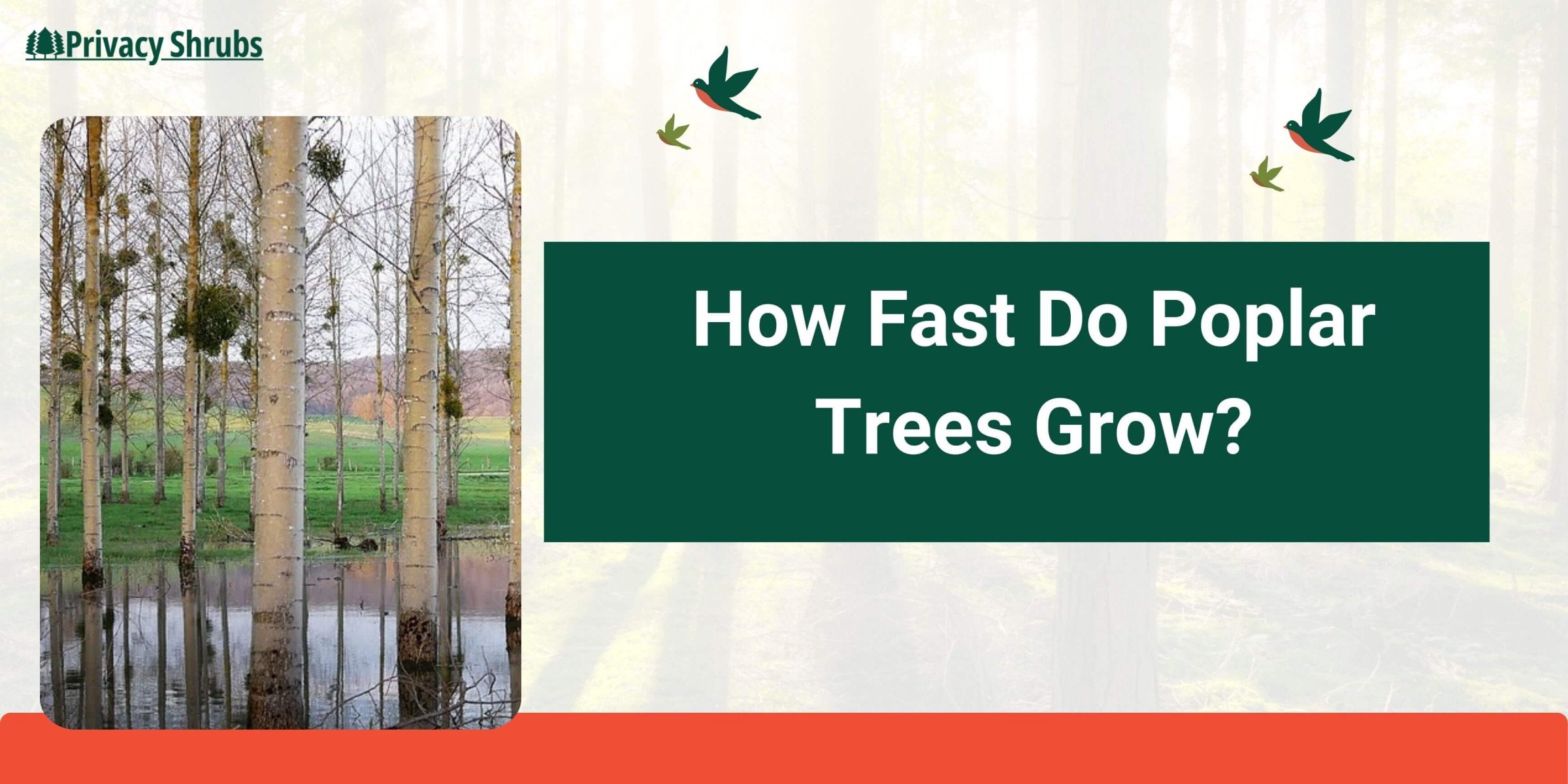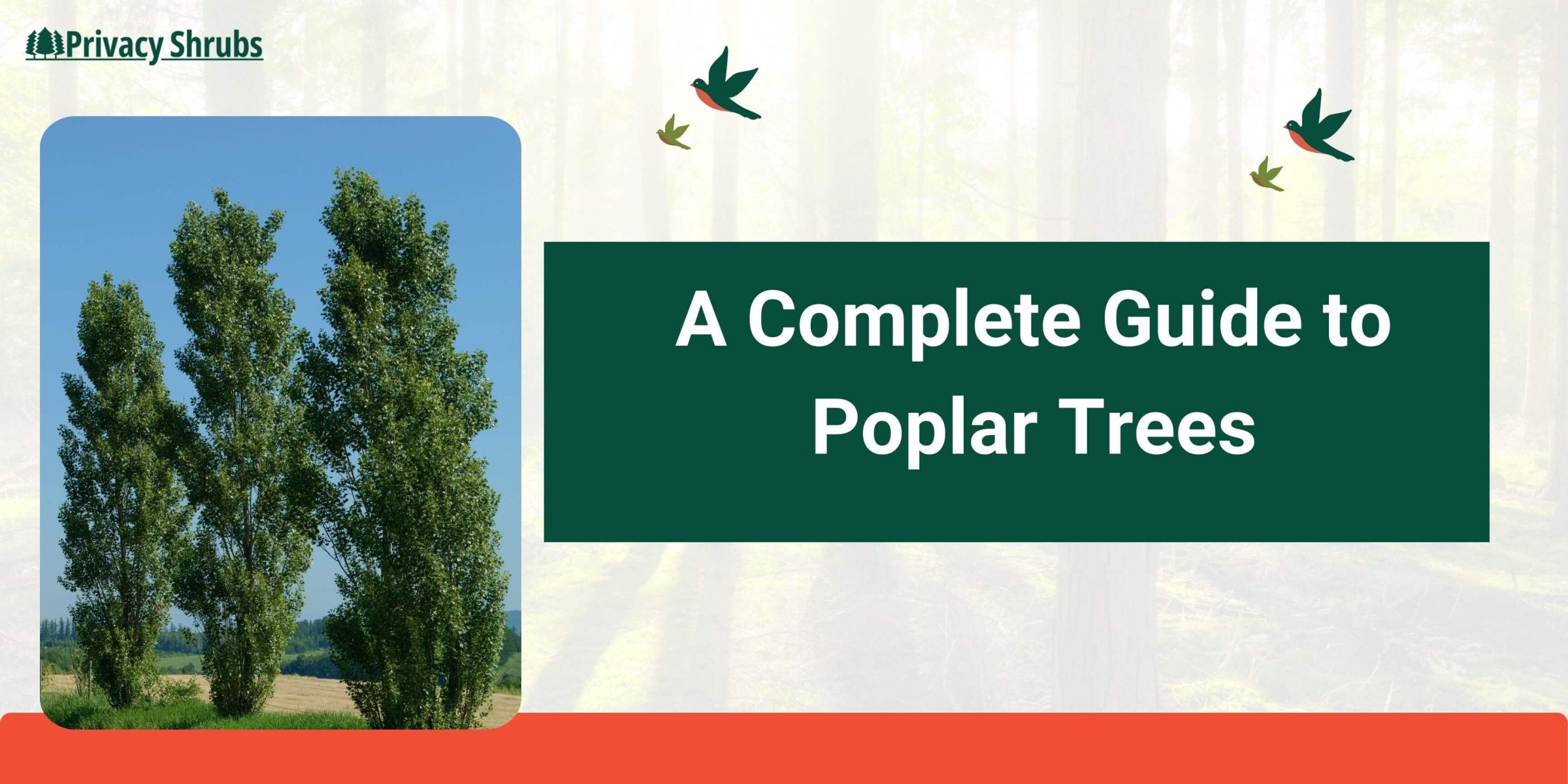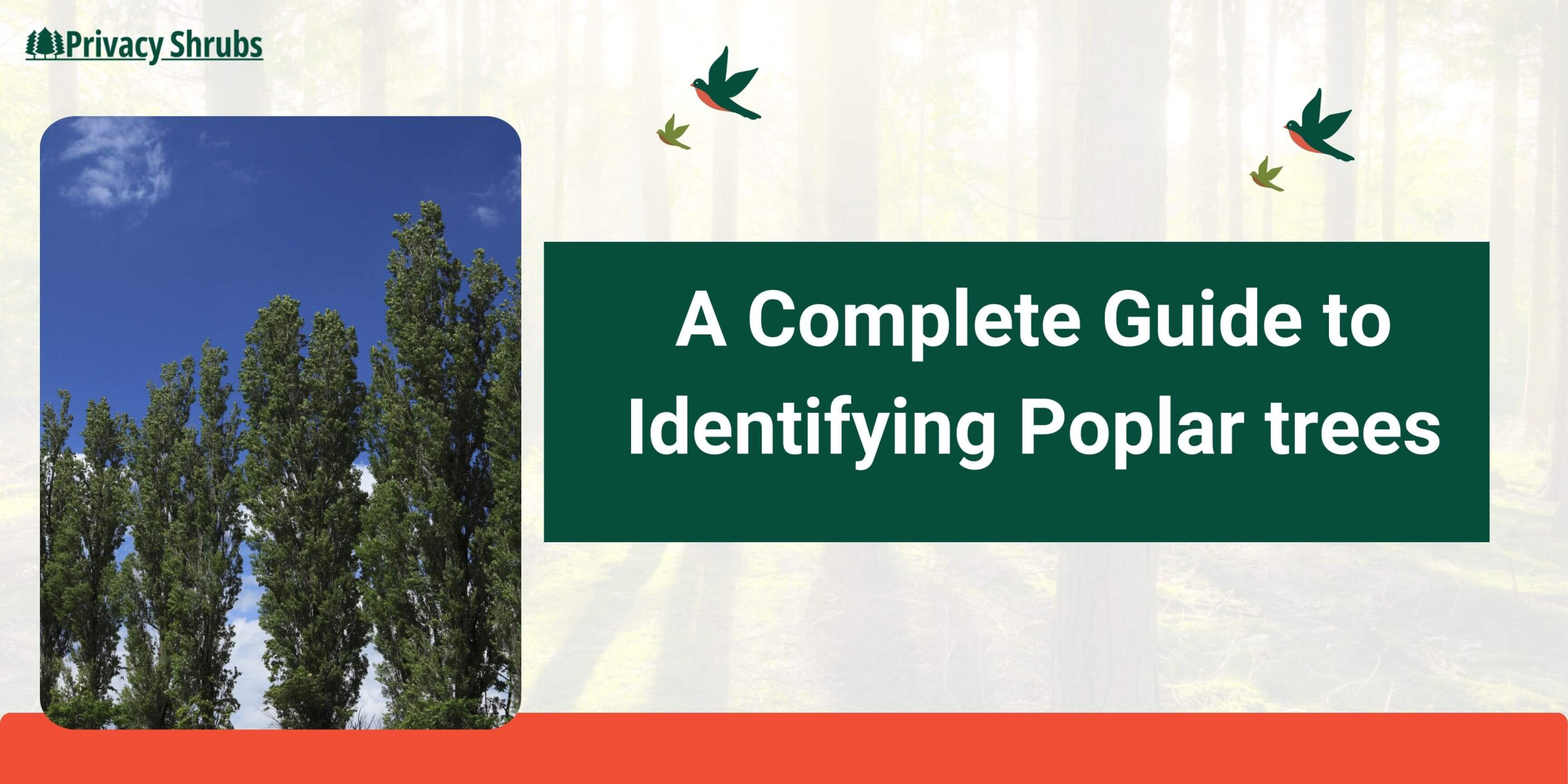Table of Contents
- Key Takeaways
- How Fast Do Poplar Trees Grow? An Introduction to Poplars
- Growth Rate of Poplar Trees
- What is the Lifespan of a Poplar Tree?
- What is The Fastest Growing Poplar?
- Growing Poplar Trees from Seed
- Poplar Tree Problems
- FAQs About Poplar Trees
- Final Take: Optimizing Poplar’s Growth and Longevity
Poplars are fast-growing trees, making them a popular choice for material manufacturing and landscaping. After all, you don’t want to have to wait years for your privacy fence or garden to do its thing.
But exactly how fast do poplar trees grow? The quick answer is that they grow from 3 to 5 feet annually, depending on their species, soil, weather, and how much TLC they have been getting.
In this blog post, we’ll share how you can optimize growth. From choosing the best species to planting and maintenance, we’ll share some common problems so you can nip them in the bud and end up with happy, healthy poplars!
Key Takeaways
Poplar trees are fast-growing trees that are a part of the genus Populus, with distinctive fluff and fluttering leaves.
Poplar trees can grow between 3 to 5 feet annually.
Species variations, soil nutrients, climate conditions, and maintenance techniques affect its growth rate.
The fastest-growing poplars are hybrid poplar and Lombardy poplar.
Common poplar tree problems include pests, fungal diseases, and structural concerns.
How Fast Do Poplar Trees Grow? An Introduction to Poplars
Poplar trees are a group of 32 species under the genus Populus, native to the Northern Hemisphere. Due to its beautiful foliage and tall stature, poplars became the go-to trees for ornamental purposes in public spaces.
Enjoying poplar trees as a landscape element is one thing, but did you know that they also contribute to the economy and environment? Here’s how!
Overview of Poplar Trees
Poplar trees have distinctive features, such as their fluff production and fluttering leaves. They also hold important environmental, aesthetic, and economic roles in their surroundings.
Characteristics and General Information
Poplar trees have a flat stalk or petioles, making them flutter and tremble when the wind hits. Their leaves can be fine to coarsely toothed, with shapes ranging from oval to heart-shaped. Most North American poplars have grayish-yellow barks that are deeply furrowed.
When fall comes, poplar leaves become yellow and shed. Because they’re deciduous trees, they lose their leaves in the fall and regain them in spring. Their flowers bloom in catkins, drooping clusters containing seeds and cotton-like fluff they release around June.
Importance in Landscaping and Forestry
Poplars can be a great addition to walkways and borders for landscaping, but their large size and shallow, invasive roots make them more suitable for larger spaces.
In terms of forestry, poplars have roles in environmental and economic purposes. Dating far back from the 18th century, people often plant poplars to protect against wind erosion and soil degradation.
In addition, they also serve as shelter for wildlife, and their wood is used for boxes, furniture, and structures.
Growth Rate of Poplar Trees
Poplar trees are known to be fast growers, sometimes reaching their maturity in under a decade.
How Fast Do Poplar Trees Grow?
Poplar trees are fast growers, but how do they compare to other trees? Find out more details on their annual growth rate and how they measure up to other fast-growing trees in North America.
Average Annual Growth Rate of Poplar Trees
Poplar trees can grow at an average rate of 3 to 5 feet annually until they reach their maximum height of about 100 feet. Most poplar trees reach maturity within 4 to 6 years after planting.
Comparison with Other Fast-Growing Trees
Poplar trees have a higher growth rate when you compare them with other fast-growing trees. See below for a comparison:
Trees | Growth rate |
Poplars | 3 to 5 feet annually |
Red Maple | 2 feet annually |
Pecan Tree | 2 to 3 feet annually |
Leyland Cypress | 3 feet annually |
American Sweetgum | 2 feet annually |
Tulip Tree | 3 feet annually |
Factors Influencing Growth Speed
Here’s a quick summary of factors affecting poplar’s growth:
Factor Affecting | Best Scenario |
Species Variations | Hybrid poplar has faster growth than others at 5 to 8 feet annually |
Soil Quality and Nutrients | Fast-draining, slightly acidic soil |
Climate and weather conditions | Zones 3-9 |
Watering and Maintenance | Keep them moist but avoid root rot, pruning may help optimize nutrient absorption |
Species Variations
Although the average growth rate of poplar trees is 3 to 5 feet annually, there are species within the Populus genus that can reach a higher growth rate. For example, the hybrid poplar can grow as much as 5 to 8 feet a year, almost twice the rate of other poplars.
Soil Quality and Nutrients
Poplars are pretty resilient, so they can grow in a wide range of soil. But for optimum growth, they prefer fast-draining sandy loam and slow-draining clay.
Poplars can utilize available nutrients efficiently, so if the soil is in good condition, there’s no need for fertilization. But if it’s extremely degraded, you may fertilize it to create a more supportive condition for growth.
Climate and Weather Conditions
Poplars generally thrive in hardiness zones 3-9, which means they prefer slightly cooler climates. However, they’re susceptible to frost damage and have softer woods that could be easily damaged during extreme weather conditions.
Watering and Maintenance Practices
Poplar trees love water, so you often find them in riverbanks. High moisture could lead to more rapid growth as the root system can spread faster. On the other hand, it’s also susceptible to root rot when overwatered.
Use well-draining soil and check the soil for dryness before watering. Regular pruning can help increase nutrient absorption efficiency, which may support growth rate.
What is the Lifespan of a Poplar Tree?
How long do poplar trees live? Unfortunately, the fast-growing tree has a relatively short lifespan. Factors such as species and environmental impact also affect how long they live.
Average Lifespan of a Poplar Tree
The average lifespan of a poplar tree is around 30 to 50 years, but this can be cut short if it’s not in its native surroundings. Find out more about the difference in lifespan between species and what kind of environmental conditions can support its longevity.
Lifespan Differences Among Species
Different species have different life spans. These are the most common poplar trees and their typical lifespan.
Hybrid poplars: Up to 50 years
Lombardy poplar: Up to 15 years
Balsam poplar: Up to 100 years
Eastern Cottonwood: Up to 20 years
Environmental Impact on Longevity
Growing conditions, such as nutrients in the soil, moisture levels, and sunlight, can affect a poplar's lifespan. Environmental stresses, such as pollution, drought, and extreme weather, can also shorten it.
Signs of Aging and Decline in Poplar Trees
When poplar trees are dying, it’s evident in their leaves, branches, and barks. In their decline, poplar trees usually have a thinning canopy, dying upper branches, and fungal growths on their bark.
What is The Fastest Growing Poplar?
Among all poplars, the fastest-growing poplar trees are hybrid poplars and Lombardy poplars. Hybrid poplars can grow 5 to 8 feet annually, while Lombardy poplars grow about 6 feet annually.
Characteristics | Hybrid Poplars | Lombardy Poplars |
Growth Rate | 5 to 8 feet annually | 6 feet annually |
Uniqueness | Produce no fluff | Columnar shape |
Hybrid Poplars
Characteristics and Uses
The hybrid poplar tree has triangular leaves with slightly rounded teeth, dark silvery green on top, and pale undersides. Unlike other poplars, it doesn’t produce cotton-like fluff in June. It’s often used as firewood, paper, and fuel and is an important nesting and roosting habitat for wildlife. Rodents, rabbits, and deer often eat its bark, twigs, and leaves.
Exceptional Growth Rates
The hybrid poplar can grow as fast as 5 to 8 feet annually, making it the fastest-growing poplar tree among the genus.
Lombardy Poplars
Unique Columnar Shape
One unique feature of the Lombardy poplar is its columnar shape and unusual branching. The branches start from the ground and grow upward, creating a much narrower dimension than other poplar species, which is why Lombardy poplars are often used as privacy screens.
Rapid Vertical Growth
The Lombardy poplar can grow 6 feet annually, placing it just behind hybrid poplars as the fastest-growing poplar trees.
Growing Poplar Trees from Seed
Are you interested in growing your poplar trees from seed? Here are a few tips and tricks you can try before you start your gardening journey.
How Fast Do Poplar Trees Grow from Seed?
Poplar trees can reach maturity from seed around 10 to 15 years after their germination. Read below to find out what you can expect during the first few years of growing.
Germination Period
Depending on their type, some poplars require a few days to germinate, while others may take 1 to 3 weeks.
Growth Expectations in Early Years
After germination, the poplar tree will go through seedling development, which may take months. Depending on the species, they will then go through structural development in the first year, growing between 15 to 25 inches.
Tips for Successful Seed Growth
For successful growth, the right seed and planting techniques. Find out more below on what you should do.
Seed Collection and Storage
The best time to collect the seeds is June and July, when they start to release their fluff. To extend their viability, it’s best to store the seeds in freezing temperatures.
Soil Preparation and Planting Techniques
Poplar seeds need to have sunlight, moisture, and soil or medium with enough nutrients to sprout.
Poplar Tree Problems
Poplar trees are susceptible to diseases, pests, and structural concerns due to their soft wood. Here are some common poplar tree problems and how you can manage them.
Common Diseases
Canker Disease
Canker disease is a fungal disease that causes sunken brown cankers on poplar twigs and branches. To manage cankers, avoid wounding trees and prune them regularly.
Leaf Rust and Spot Diseases
Leaf rust and spot are infections due to fungal disease. To manage the risk, avoid planting other susceptible plants near poplars, space plants properly, prune regularly, and destroy infected leaves.
Pest Issues
Poplar Borer Infestations
These are larvae that bore into the wood and leave black stains on the bark, leading to rot. To manage the condition, make sure the tree is properly watered, remove infected areas, or use insecticides.
Aphid Attacks
Aphid feeds on plant sap, causing the leaves to turn yellow and stunt shoots. To manage the condition, do regular physical checks, release natural predators like ladybugss, or use insecticides.
Structural Concerns
Brittle Wood Leading to Limb Breakage
Poplars have soft and brittle wood, which makes them susceptible to breakage. Do regular trimming to avoid trunk splitting and protect it from disease or pests.
Invasive Root Systems Affecting Infrastructure
One of the most common concerns is poplar’s invasive roots, which could damage pavements or structures. To avoid ruining your infrastructure, plant poplars away from structures and opt for open spaces.
Poplars have soft and brittle wood, which makes them susceptible to breakage. Do regular trimming to avoid trunk splitting and protect it from disease or pests.
Where to buy Poplar Tree
When looking to purchase poplar trees for your privacy needs, Privacy Shrubs is the best place to find healthy, well-developed specimens with established root systems that will quickly create the natural screen you desire.
Unlike general garden centers, we focus exclusively on privacy trees and shrubs, offering expert guidance on spacing, planting patterns, and maintenance specific to creating effective boundaries.
Our selection includes multiple poplar varieties known for their exceptional growth rates, allowing you to achieve privacy in just a season or two rather than waiting years.
FAQs About Poplar Trees
How Long Does It Take to Grow a Poplar Tree?
Typically, a poplar tree takes 4 to 6 years to reach maturity and maximum height.
What is the Speed of Growth of Poplar?
Poplar trees grow 3 to 5 feet annually, making them one of the fastest growing trees in the world.
What is the Lifespan of a Poplar Tree?
The lifespan of a poplar tree is between 30 to 50 years, depending on its environment and maintenance.
What is the Fastest Growing Poplar?
Hybrid poplar is one of the fastest growing trees, which is a cross of the eastern cottonwood and black poplar. It grows between 5 to 8 feet annually.
Final Take: Optimizing Poplar’s Growth and Longevity
Poplars are fast-growing trees, averaging 3 to 5 feet annually. The fastest-growing poplar is the hybrid poplar, which grows 5 to 8 feet annually.
It has a short lifespan, but you can optimize it by choosing the right species, protecting it from diseases and pests, and using the right planting and maintenance techniques.



















